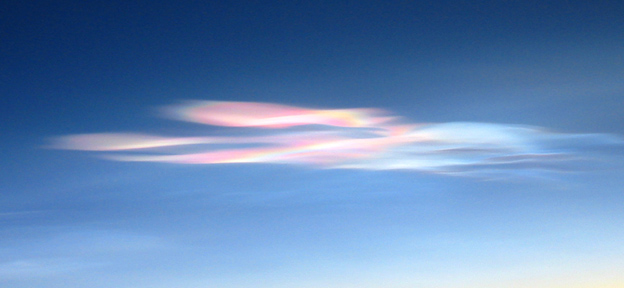Editors’ Vox is a blog from AGU’s Publications Department.
During the polar winter and spring, when temperatures are very low, clouds can be observed in the stratosphere above the polar regions, typically at around 12 to 30 kilometers in altitude. Unlike tropospheric clouds, which are liquid water or ice, these “polar stratospheric clouds” (PSCs) can be ice, solid nitric acid trihydrate (NAT) crystals, supercooled liquid ternary (sulfuric acid/nitric acid/water) solution (STS) droplets, or combinations of these. An article published in Reviews of Geophysics describes how new satellite instruments have improved our understanding of PSC occurrence and composition. Here, one of the authors describes what we know about PSCs and the role they play in ozone depletion.
How do PSCs effect atmospheric chemistry in the stratosphere and why is this important?
PSCs play key roles in the chemical depletion of stratospheric ozone in the polar regions, the most prominent manifestation being the ozone “hole” that forms over Antarctica each September. With less ozone in the stratosphere, more biologically damaging ultraviolet radiation reaches the Earth’s surface.
With less ozone in the stratosphere, more biologically damaging ultraviolet radiation reaches the Earth’s surface.
PSC particles host mixed-phase chemical reactions on their surfaces that activate chlorine, transforming it from relatively inert gaseous species (such as HCl and ClONO2) into ozone-destroying forms. Rates of these reactions vary with PSC particle composition and surface area.
Secondly, the gravitational sedimentation of large PSC particles acts to scavenge reactive nitrogen (a process called “denitrification”), which can then no longer deactivate the chlorine, thus prolonging the ozone destruction cycle.
How long have scientists known about PSCs and the role that they play?
There are records of visual PSC sightings from the ground, primarily during Arctic winter, dating back to the 1870s. Nearly all of these sightings were so-called mother-of-pearl ice clouds, which form in the crests of atmospheric waves induced by flow over mountainous terrain.

Only with the dawn of the satellite remote sensing age in the late 1970s was it found that PSCs occur over large areas in both the Arctic and Antarctic and are observed over much of the winter in the Antarctic. And it wasn’t until the discovery of the Antarctic ozone hole in 1985 that a linkage between PSCs and ozone depletion was hypothesized and subsequently confirmed.
What different instruments and techniques have been used to observe PSCs?
Because of the high altitude of PSCs and the operational difficulty of conducting experiments during polar winter there are relatively few in-situ measurements of PSCs. The bulk of PSC observations have been made via remote sensing, wherein the occurrence and composition of PSCs is inferred through changes in optical or infrared signals induced by the clouds. These include passive measurements such as the spectral signature of infrared radiation emitted by the PSC, or changes in solar radiation as it traverses the PSC. There are also active measurements using lidar, which provides a high-vertical resolution depiction of PSCs from the backscatter of laser light pulses by the cloud particles.
How have the data gathered from spaceborne instruments advanced our understanding of PSC occurrence and compositions?
Contemporary spaceborne measurements have advanced our understanding of PSC formation processes and climatology in many ways. We now know that STS-NAT mixtures are the predominant composition of PSCs over most of the winter in both hemispheres, and that the uptake of gas-phase nitric acid by the clouds depends strongly on how fast the air is cooling. In rapid cooling situations, uptake is dominated by liquid STS droplets, whereas in cases with slow cooling, thermodynamically favored NAT particles are predominant. We are now confident that NAT particles form at temperatures above the frost point through some selective nucleation mechanism, perhaps involving meteoritic dust.
Contemporary spaceborne measurements have advanced our understanding of PSC formation processes and climatology in many ways.
In terms of climatology, PSC occurrence in the Antarctic is very similar from year-to-year, whereas each Arctic PSC season is unique due to the much greater variability in wintertime temperatures there. Also, comparison of contemporary measurements with data from 1979 to 1989 suggests there has been an increase in Arctic PSCs in December and January, possibly associated with climate change.
What are some of the unresolved questions where additional research, data, or modeling is needed?
Most recent analyses of satellite PSC observations have assumed that NAT particles are nearly spherical. However, some infrared observations of large NAT particles can only be reconciled by assuming the particles have needle or disc-like shapes. Measurements of NAT particle shape would lead to more realistic calculations of NAT optical properties and improve the future characterization of PSC composition.
The denitrification observed in both polar regions provides evidence for a selective NAT particle nucleation mechanism that results in NAT number densities that are optimum for denitrification. Why and how do the cold polar vortices routinely and naturally produce such a seemingly optimum number density of NAT nuclei?
Many models produce reasonable ozone depletion results for very cold Antarctic winters despite having crude representations of PSCs because the chlorine activation process is “saturated” and does not depend on the details of chemical reactions on PSCs or denitrification.
However, when temperatures are near the PSC formation threshold – as is often the case in the Arctic – an accurate PSC scheme will yield much better model results than simple approximations. Thus, it remains important to better understand and simulate PSC processes in detail, especially when considering PSC effects in the face of a changing climate.
—Lamont R. Poole ([email protected], ![]() 0000-0003-2396-7559), Science Systems and Applications, Inc., USA
0000-0003-2396-7559), Science Systems and Applications, Inc., USA

